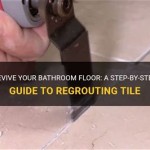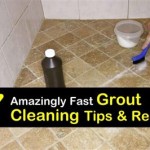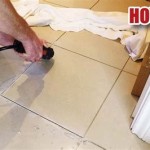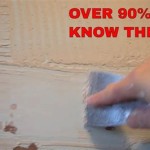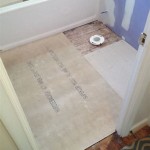How To Remove Ceramic Tile Glue From Concrete Floor Without Damaging the Concrete
Removing ceramic tile glue, also known as thin-set mortar or adhesive, from a concrete floor requires patience and the appropriate tools. This task is often encountered during remodeling projects, when outdated or damaged tiles are being replaced. The goal is to eradicate the glue effectively without causing significant damage to the underlying concrete surface. Damage to the concrete can necessitate costly repairs and potentially compromise the structural integrity of the flooring system. Therefore, selecting the correct removal method and proceeding with caution is paramount.
The difficulty of removing ceramic tile glue depends on several factors. These include the type of adhesive used, the age of the adhesive, and the porosity of the concrete surface. Older adhesives tend to be more brittle and may respond better to certain removal techniques. Conversely, modern adhesives, especially those incorporating epoxy or urethane polymers, can prove more resistant. The porosity of the concrete influences how deeply the adhesive has penetrated the surface. A more porous surface will likely present a greater challenge.
Preparation is essential before attempting any removal method. This includes gathering the necessary tools and safety equipment, and adequately preparing the work area. Protective gear such as safety glasses, gloves, and a dust mask is crucial to prevent injury and inhalation of harmful dust particles. The area should be well-ventilated to minimize exposure to dust and potential chemical fumes generated during the process. Covering nearby surfaces with plastic sheeting can help prevent the spread of dust and debris, simplifying cleanup afterward.
Softening the Adhesive: Chemical or Mechanical Methods
The initial step generally involves softening the adhesive to make it more pliable and easier to remove. Several methods can be employed to achieve this, involving either chemical solvents or mechanical abrasion, or a combination of both. The choice of method depends on the type of adhesive, the extent of the residue, and the desired level of concrete surface preservation.
Chemical solvents designed to dissolve or soften adhesives are readily available at most hardware or home improvement stores. These solvents typically contain chemicals like methylene chloride or citrus-based degreasers. When using chemical solvents, it is imperative to carefully follow the manufacturer's instructions regarding application, dwell time, and safety precautions. Adequate ventilation is essential, and appropriate personal protective equipment (PPE) must be worn. After the recommended dwell time, the softened adhesive can often be scraped away more easily with a putty knife or scraper.
Mechanical methods, such as using a heat gun or hot water, can also be effective in softening certain types of adhesives. A heat gun applied cautiously can heat the adhesive, making it more pliable for scraping. Hot water, when poured onto the adhesive and allowed to soak for a period, can also soften the bond between the adhesive and the concrete. However, these methods should be used with caution to avoid damaging the concrete surface. Excessive heat can cause the concrete to crack or spall, while prolonged exposure to water can lead to moisture-related problems.
Another mechanical method involves using specialized tools like a floor scraper or a power scraper with a flat blade attachment. These tools are designed to remove adhesive residue without excessively gouging or scratching the concrete. When using a power scraper, it is vital to maintain a consistent angle and pressure to prevent uneven removal and potential damage. Slow and steady passes are more effective than attempting to remove large chunks of adhesive at once. The key is to work systematically, gradually removing the adhesive layer by layer.
Removing the Softened Adhesive: Scraping and Chipping
Once the adhesive has been softened, the next step involves the physical removal of the residue from the concrete surface. This process typically involves using a combination of scraping, chipping, and potentially grinding. The specific tools and techniques employed will depend on the type of adhesive, the extent of the residue, and the desired final surface preparation.
Hand scrapers of various sizes and shapes are essential tools for removing softened adhesive. A narrow, stiff-bladed scraper is ideal for removing adhesive from edges and corners, while a wider scraper is more efficient for larger areas. The scraper should be held at a shallow angle to the concrete surface, and firm, consistent pressure should be applied to remove the softened adhesive. Care should be taken to avoid digging the scraper into the concrete, which can create unsightly scratches and gouges.
For stubborn areas or thicker adhesive deposits, a chisel and hammer may be necessary. The chisel should be held at a low angle to the concrete surface, and gentle taps with the hammer should be used to break the bond between the adhesive and the concrete. Again, caution is advised to avoid striking the concrete too forcefully, as this can cause chipping or spalling. The goal is to gradually chip away at the adhesive without damaging the underlying concrete.
In some cases, a floor buffer or grinder with an abrasive pad may be used to remove residual adhesive. This method is particularly effective for removing thin layers of adhesive or for smoothing out any imperfections left behind by scraping or chipping. When using a grinder, it is crucial to select the appropriate abrasive pad for the type of adhesive and the desired level of concrete surface preparation. A coarse grit pad can be used for initial removal, followed by a finer grit pad for smoothing. Maintaining a consistent pressure and avoiding excessive grinding in one area is essential to prevent uneven removal and potential damage to the concrete.
During the removal process, it is important to regularly clean the work area to remove loose adhesive residue and dust. This will help to maintain visibility and prevent the adhesive from being spread to other areas. A shop vacuum is ideal for removing dust and debris, while a damp cloth can be used to wipe down the concrete surface.
Final Surface Preparation and Cleaning
After the majority of the adhesive has been removed, the final step involves preparing and cleaning the concrete surface to ensure it is ready for the next stage of the flooring project. This typically involves removing any remaining adhesive residue, smoothing out imperfections, and thoroughly cleaning the surface to remove dust, debris, and any remaining chemical or solvent residue.
A concrete grinder with a diamond grinding wheel is often used to remove any remaining adhesive residue and to smooth out imperfections in the concrete surface. The diamond grinding wheel is designed to abrade the concrete surface without causing excessive chipping or scratching. When using a grinder, it is essential to wear appropriate personal protective equipment, including a dust mask, safety glasses, and hearing protection. The grinder should be operated in a systematic manner, moving in overlapping passes to ensure consistent removal and smoothing.
Concrete resurfacing compounds can be used to fill in any cracks, chips, or gouges in the concrete surface. These compounds are typically mixed with water and applied with a trowel to create a smooth, even surface. Before applying the resurfacing compound, the concrete surface should be thoroughly cleaned and primed to ensure proper adhesion. The resurfacing compound should be allowed to dry completely before proceeding with any further surface preparation.
Finally, the concrete surface should be thoroughly cleaned to remove any remaining dust, debris, and chemical residue. A shop vacuum is ideal for removing loose dust and debris, while a concrete cleaner or degreaser can be used to remove any remaining chemical residue. The concrete surface should be allowed to dry completely before applying any sealant, primer, or new flooring material. Proper surface preparation is crucial for ensuring the long-term adhesion and performance of the new flooring system. Careful execution of these steps will contribute to a successful flooring project and minimize the risk of future problems.

How To Remove Tile From A Concrete Floor

How To Remove Tile Adhesive Maid2match

How To Remove Tile Glue From Concrete Stone Protection

How To Remove Floor Tiles From Concrete Our Guide

How To Remove Tile Adhesive Maid2match
Removing Old Tile Adhesive From Floor Tilers Forums

How To Remove Old Floor Tile Adhesive All Stripped

Dust Free Thinset Removal

How To Remove Ceramic Tile And Thinset The Nifty Nester

How To Remove Ceramic Tile From Concrete Floor Rubi Blog Usa
Related Posts


